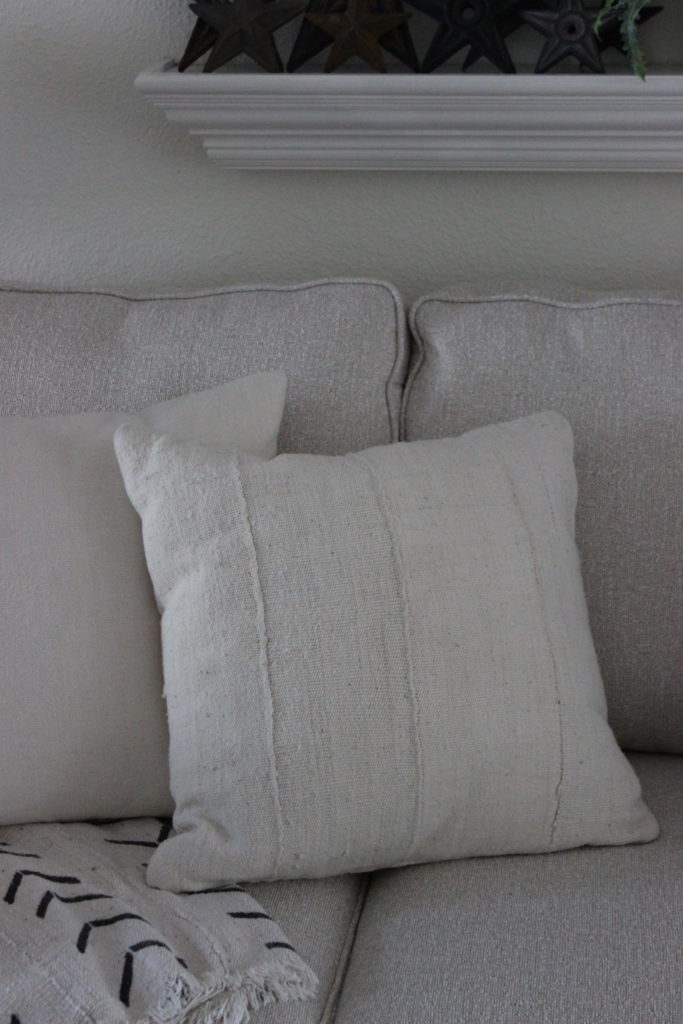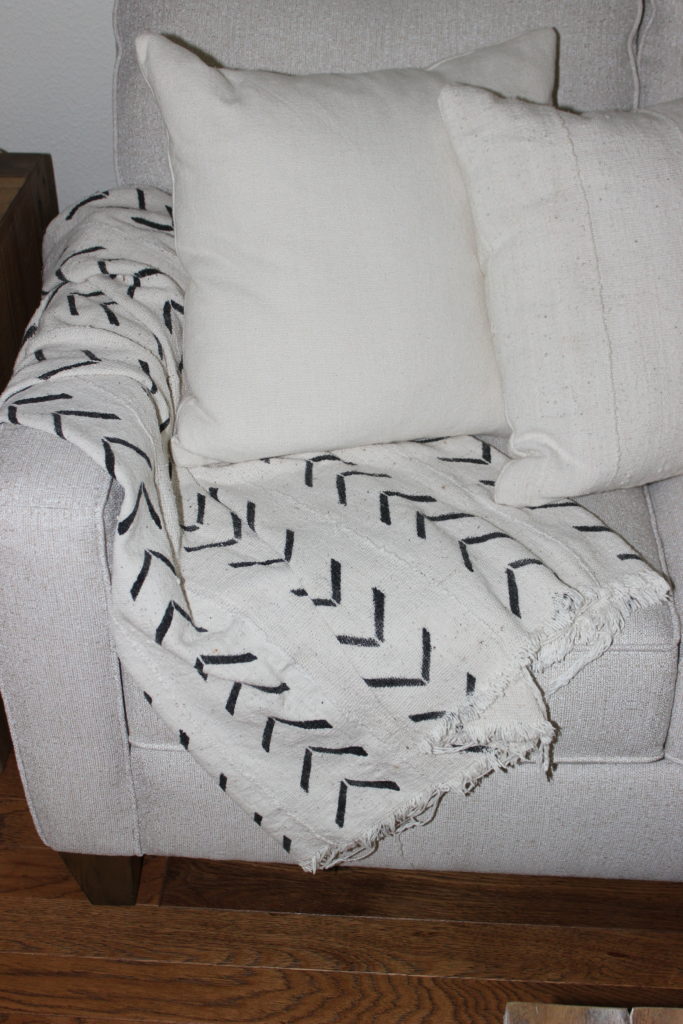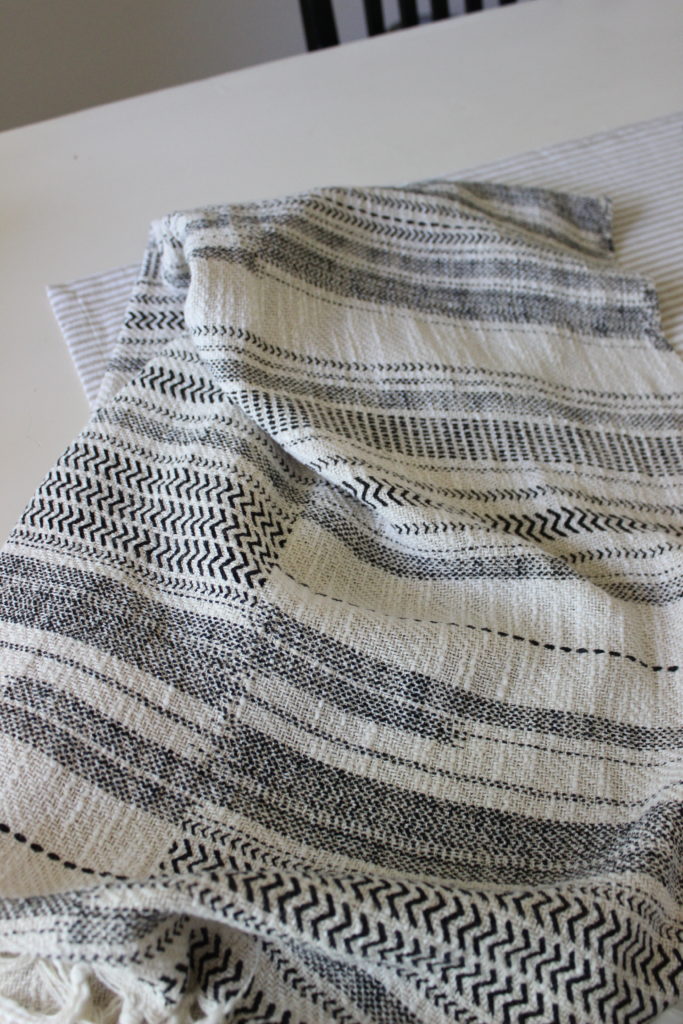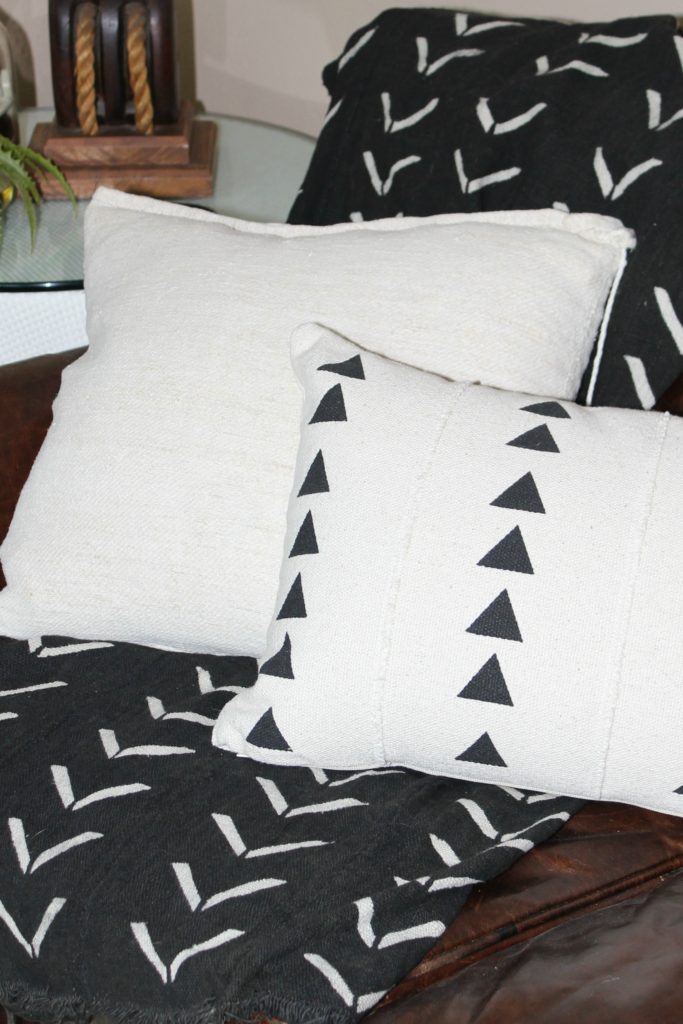

June 24, 2020
Just before the pandemic hit with a giant fist, I became fascinated with Mud Cloth. It’s another one of those things I now love that had escaped my attention. How is that possible??? Mud Cloth has been around since the 12th century for cryin out loud! It’s been featured on fashion runways, from mini skirts to jackets, and for the home; made into pillows, runners, napkins, coasters, used as rugs and for furniture upholstery. How did this escape my notice? Me, the lover of textiles? I don’t know, nor really care, I’m just happy to have found it.

My love affair began without fanfare a few years ago. I’m always searching for affordable european grain sacks and/or fabric. I love its nubby feel, the differences in the weave, thickness and softness, the history. All of it. While browsing at a booth during one of our area’s flea markets, I stumbled upon a white pillow made from coarse fabric, and appeared to be made from strips of cloth sewn together. I knew it wasn’t hemp or flax linen, the traditional grain sack material, but it was beautiful to me and I was instantly smitten. When asked, the vendor said she didn’t have another and couldn’t remember where she’d found this one. Disappointed in not learning the origin of the pillow, I paid $20.00 ( a great price!) and wandered through all the other booths, hoping to find another pillow or fabric. None could be found. Every year, every flea after that I searched for the fabric but was always disappointed.

Fast forward to February of 2020 and the Renningers Extravaganza, one of 3 large flea markets held each year in Mt Dora, Florida. Renningers Market is open all year in the 3 indoor climate controlled buildings, every 3rd weekend of the month it adds outdoor vendors, and opens its permanent cottages in addition to the 3 main buildings, BUT 3 times a year all the acreage is open and there are hundreds of booths. It’s a vintage lover’s paradise. I was just a few booths in when I saw a bed covering hanging from a makeshift rod under an oak tree. I couldn’t believe my eyes! It was my cloth!! Not only that but there were piles of it! Eureka, gadzooks and ring the bell! I’d hit the Mother Lode.
I saw several stacks of cloth in various sizes and colors, a few were the solid white of my pillow, but most had geometric designs. Some pieces were small and suitable for making throw pillows, or table runners, and there were tables that held piles of sizes from approximately 4 x 6 feet to 8 x 10. Larger pieces had been sewn into coverings for beds in standard sizes. The full sized coverlet I’d admired was tagged at $225.00. I admired it but passed.
I soon found 3 other booths offering the cloth and finally stopped to speak to a vendor. He told me it was Mud Cloth, he was from New York and imported his fabrics from Africa. It was the first time he and the other vendors, all friends of his, had set up at Mt Dora. They have regular booths at the Brooklyn Flea, and decided to expand and try some other regional markets. I bought a white on black piece, left behind a more intricate brown, black and white patterned one (regretted that as soon as I got home) and went on with my shopping.

I made it a point to learn about Mud Cloth. It’s been around since the 12th Century. It’s origin is Mali, West Africa and is part of the Malian culture. The name comes from the native language, Bamabra: Bo´go´lanfini, bogo (earth) lan (with) fini (cloth) or “Mud Cloth.” It’s worn by hunters as protection and as a symbol of status. Men traditionally sew strips of hand loomed cotton together and women dye the fabric using fermented river mud.
It’s a long process involving layers of mud collected from different rivers and streams, fermented for a year, layered on the cloth, washed off, layered again and then bleached and dried in the sun. The designs are hand painted, each symbol has a meaning or tells a story. Dye is made from tree leaves, bark and grasses, and once painted, the cloth is dried in the sun for another week, then washed, and dried again.
Mud Cloth is still being produced in Mali, mostly for the tourist trade and now mostly loomed and dyed by men. One theory is that men took it over to free up women for more traditional home duties. (Not sure how I feel about that!)
There are Fair Trade sources, so if you’re looking to purchase on-line, be sure to ask the origin of the cloth and if it is fair trade. It’s important that we shop Fair Trade to keep the money where it belongs…with the people who are involved in creating this labor intensive craft and not big box stores. I found several vendors on Etsy and did purchase another piece there, a black on white, the opposite of the first one purchased at the flea. They’re interchangeable in my rooms since most of my home is now done in whites, blacks and browns. (I wasn’t smart enough to write down the vendor name, nor did I keep the receipt. Insert frowny face). I’m in the process of researching a Fair Trade list of vendors that I hope to share in another post.
If you buy Mud Cloth be aware that since it’s hand dyed with organic materials it’s going to vary in color, no two pieces are alike and it needs to be cared for gently. I was told to swish it gently in a tub with Castile soap, rinse well and hang or spread out to air dry away from direct sunlight to prevent fading. It can be dry cleaned, but some cleaners won’t clean hand made fabrics, so check first. Also wash it alone because hand dyed fabrics may bleed. I think it’s worth the effort however. I love that its nubby feel, rustic look, and heavy weight coordinates well with my grain sacks, adds texture and that unique quality that only one of a kind items have.

Mud Cloth is often used in modern and BoHo design (again how did I not know this??) and there are many products with the Malian symbols reminiscent of Mud Cloth. But this beautiful cloth fits in just as easily in a Modern Farmhouse or Country home. It’s hand made, it’s humble, it’s rich in history….. why wouldn’t we vintage lovin country design folk love it too? My two pieces are being used as throws on my sofas, I’m now also the proud owner of 2 throw pillows. I love the texture they bring and the story they tell. I hope you’ll take a look at this fabric and find ways to use it in your home as well.
Be well, be happy. And remember, You can create your sanctuary no matter where you live. Love the home you’re in.
Spread the Joy!So much fun to learn more about mud cloth! I love your pillows and throw too. They’re fabulous. I can see how they would easily blend into many different styles and add subtle layers of texture too. I’ll be keeping my eyes peeled for it when I’m treasure hunting at outdoor events. I miss them so much! Hope your day is a special one, CoCo
Hi there Crystal! I completely agree! I fell in love with mud cloth the minute I saw it too! It can be hard to find but flea markets have been my main source also! I’ve had several pillows made in different sizes and shapes! i like how it adds a little modern vibe to a room with the geometric designs. It’s a perfect companion to the Antique Advertising Pots too that we both love! I think I have at least one pillow or throw in every room of my house! Love, love, love it! Thank you for sharing!
Hi Carol! I knowwww. I love it so much. And you are the only other person I know who knows about it! Everyone else is like, huh? Mud Cloth? I had never seen it around here locally and I searched for about 3 years. Until this past February. As popular as it is in Boho and Modern design you’d think it would show up here, but nope! I hope those same vendors come back to Mt Dora, after it’s safe, I’d love to get more fabric and their prices are really great. I found several vendors on Etsy but none that were Fair Trade, I’m going to look again. But there’s a great Website, Life in Spirit Home, there’s a .com blog and they are Fair Trade if you are interested. Thanks for following along my friend!
AND HOW IS IT YOU NEVER MENTIONED SAID MUD CLOTH TO ME LIKE EVER??? LIKE FOR REAL NEVER EVER????????
😭😭😭😭😭 sending you my love and my favorite person meme – you know the one!
Love ya!
What? I never mentioned it? Like ever???? Do I need to apologize? I’m so very sorry, I guess we talk about so many other things…. bet you’ll recognize it now in rooms in magazines, it’s everywhere. And I can’t believe I didn’t know what it was until February!!
Yep, I’m one of those: “Huh??? Mud cloth ?!!” The closet I’ve come to mud cloth is actual, well , you know, mud ..on a cloth ( 3 boys who all played little league baseball- Fels Naptha , I need you!) Seriously your wealth of information and writing about it is so intriguing!
Ha Christiann, boys and mud just go together like…. mud cloth! Google is my best friend when it comes to learning about my new interests. And girl! I just bought a bar of Fels Naptha because….. Mr B 🙂
7 Comments